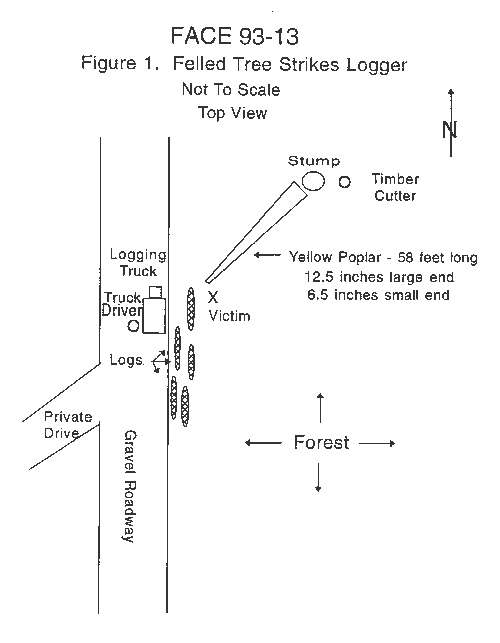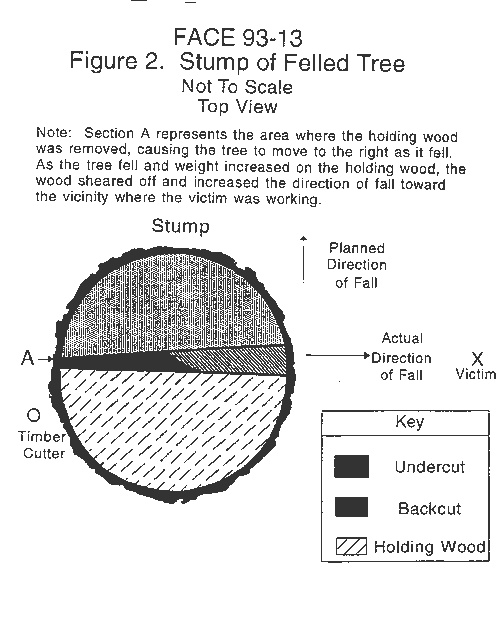Foreman/skidder Operator Killed by Falling Tree - West Virginia
FACE 9313
SUMMARY
A 51-year-old male foreman/skidder operator (the victim) was bucking trees at a logging site in a rural part of the state when he was struck by a falling tree. The victim and two co-workers were performing separate logging operations when the incident occurred. A timber cutter was felling trees nearby while the victim was using a skidder to move the felled trees to the landing area for bucking into smaller-sized saw logs. The victim was bucking up the trees with a chain saw when the timber cutter felled a yellow poplar tree that fell in the victim’s direction. Although the timber cutter and another worker yelled a warning to the victim, who was wearing a protective helmet and ear plugs, the victim was struck on the head and died instantaneously. NIOSH investigators concluded that, to prevent similar occurrences, employers should:
- ensure that workers are assigned to separate work areas
- develop, implement and enforce a written safety program which includes worker training in proper tree felling techniques
- designate a competent person to conduct regular safety inspections.
INTRODUCTION
On March 22, 1993, a 51-year-old male foreman/skidder operator (the victim) was struck and killed by a falling tree that had been felled by another worker in the vicinity. On March 26, 1993, officials of the local county sheriff’s office in West Virginia were contacted by the Division of Safety Research (DSR) about this fatality and were offered technical assistance. On March 27, 1993, a DSR safety specialist investigated this incident. The investigator reviewed the incident with the county sheriff, the victim’s co-workers, and the OSHA compliance officer assigned to the case. The medical examiner’s report and photographs were obtained during the investigation.
The employer in this incident was a small logging company that had been in operation for about 10 years and currently had six employees. The employer did not have a written safety policy, safety program, or established safe work procedures at the time of the incident. Two workers had received first-aid training two weeks before the incident. The victim had been employed by the company for 5 years, and had about 12 years of logging experience. This incident was the first fatality the company had experienced.
INVESTIGATION
The company had purchased the timber rights on a 3-acre tract of land where a variety of trees was to be clearcut for sawtimber. The workers had been clearcutting for three days. The tree that was being felled at the time of the incident was the last tree to be cut for this timbering job. Three workers were assigned to the work site—one foreman/skidder operator (the victim), one timber cutter, and one truck driver. The terrain was a gentle rolling mountain slope with less than a 5-percent grade.
On the day of the incident, the employees commenced work at about 8 a.m. Only a few trees remained to be cut, limbed, bucked, and transported to the saw mill. The timber cutter began felling trees while the victim used the skidder to pull a number of trees to the landing area. The truck driver had just returned to the landing area after transporting a load of saw logs to the saw mill. He positioned the truck on a gravel roadway alongside the landing area and began using the picker—a loading device operated by hydraulics and located on the back of the truck—to load the logs. At the time of the incident the timber cutter was felling a yellow poplar located about 50 feet away from the victim. The tree was about 58 feet long, 12.5 inches in diameter at the butt, and 6.5 inches in diameter at the smaller end (Figure 1). An undercut had first been made in the tree, and the backcut had just been completed. The undercut was made in such a manner that the tree was to have fallen at a 90-degree angle away from the victim. But when the backcut was made, approximately one-third of the hinge (holding wood) was cut through, allowing the tree to twist on its stump and fall in the direction of the victim (Figure 2). Both co-workers saw the tree twist on its stump and fall toward the victim, and they both shouted a warning. The victim was stooped over using a chain saw to buck a tree. He was wearing a protective helmet and ear plugs; he apparently did not hear the warning, and was struck on the head by the falling tree.
Both co-workers ran to the victim and checked him for a pulse and to determine if he was breathing. When neither was detected, one co-worker performed cardiopulmonary resuscitation while the other ran to a nearby house and had the homeowner call 911 for assistance. The local fire department personnel arrived in 5 to 6 minutes and the emergency medical service (EMS) arrived in 11 minutes. After assessing the situation, the EMS called the medical examiner who instructed them to transport the body to the local morgue.
CAUSE OF DEATH
The medical examiner’s report listed the cause of death as a fractured skull.
RECOMMENDATIONS/DISCUSSION
Recommendation #1: Employers should ensure that workers are assigned to separate work areas.
Discussion: Two workers, a timber cutter and the victim, were working approximately 50 feet away from one another when the incident occurred. 29 CFR 1910.266(e)(1)(i) states “Work areas shall be assigned such that a tree cannot fall into an adjacent work area. The recommended distance between workers is twice the height of trees being felled.”
[Note: Currently, OSHA standard 1910.266 applies to pulpwood logging but does not apply to the logging of sawtimber-sized trees, the type involved in this incident. OSHA is revising its logging regulations to include all types of logging operations. Although not enforceable, sections of 1910.266 of the pulpwood standard, particularly relating to safe work practices, do apply in this case.]
Recommendation #2: Employers should develop, implement and enforce a written safety program which includes worker training in proper tree felling techniques.
Discussion: Written safety programs should describe safe work procedures for all tasks to be conducted, and include discussions of appropriate tools and protective equipment. Additionally, training should be provided to all workers to ensure they are aware of the safe work procedures to be followed. In this incident, the victim was struck and killed by a falling tree as he was bucking up another tree about 50 feet away. The tree that struck him had been undercut in such a manner that it was supposed to have fallen away from the victim. However, when the backcut was made, the holding wood was cut about one-third of the way through. This action caused the tree to twist on its stump and fall in the direction of the victim, approximately 90 degrees away from the intended direction of fall.
Recommendation #3: Employers should designate a competent person to conduct regular safety inspections.
Discussion: Conducting regular safety inspections of all logging tasks–among other safety-related responsibilities–by a competent person will help ensure that established company safety procedures are being followed. Additionally, scheduled and unscheduled safety inspections of tree felling worksites clearly demonstrate that the employer is committed to the safety program and to the prevention of occupational injury.
REFERENCE
Office of the Federal Register: Code of Federal Regulations, Labor 29 Part 1910.266, p. 680. July 1, 1989.
 image icon
image icon

